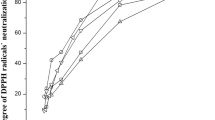Abstract
The seed of Zanthoxylum bungeanum (Z. bungeanum) is a by-product of pepper production and rich in unsaturated fatty acid, cellulose, and protein. The seed oil obtained from traditional producing process by squeezing or extracting would be bad quality and could not be used as edible oil. In this paper, a new preparation method of Z. bungeanum seed kernel oil (ZSKO) was developed by comparing the advantages and disadvantages of alkali saponification-cold squeezing, alkali saponification-solvent extraction, and alkali saponification-supercritical fluid extraction with carbon dioxide (SFE-CO2). The results showed that the alkali saponification-cold squeezing could be the optimal preparation method of ZSKO, which contained the following steps: Z. bungeanum seed was pretreated by alkali saponification under the conditions of adding 10 %NaOH (w/w), solution temperature was 80 °C, and saponification reaction time was 45 min, and pretreated seed was separated by filtering, water washing, and overnight drying at 50 °C, then repeated squeezing was taken until no oil generated at 60 °C with 15 % moisture content, and ZSKO was attained finally using centrifuge. The produced ZSKO contained more than 90 % unsaturated fatty acids and no trans-fatty acids and be testified as a good edible oil with low-value level of acid and peroxide. It was demonstrated that the alkali saponification-cold squeezing process could be scaled up and applied to industrialized production of ZSKO.

Similar content being viewed by others
References
Cao X.L, Ito Y (2003) Supercritical fluid extraction of grape seed oil and subsequent separation of free fatty acids by highspeed counter-current chromatography. J.Chromatogr.A. (1021):117–124
De-bo L (1999) Study on preparation of Zanthoxylum bungeanum seed oil. China West Cereals Oils Technol 24(5):22–23
Fang L, Xiu D (2007) Comparison of three extractionmethods to extract Zanthoxylum oil. Chin Tradit Patent Med 4(27):391–394
Heng L, Li C, Jia M et al (2005) Therapeutic effect of pericarpum Zanthoxylum oil on experimental hyperlipernia in mice. Med J China PLA 30(11):1012–1013
Jain N, Srivastava SK, Aggarwal KK et al (2001) Essential oil composition of Zanthoxylum alatum seeds from northern India. J Flavour Fragr Journa 16(6):408–410
Jun-hua Z, Li-feng J (2008) Acid-catalyzed esterification of Zanthoxylum bungeanum seed oil with high free fatty acids for biodiesel production. J Bioresour Technol 99(18):8995–8998
Qian Y, Si-wang W, Jianbo W et al (2007) Comparative study of three M ethods of the extract olein from Bunge pricklyash seed. Chin J Exp Tradit Med Formulae 3(13):20–22
Ramidi R, Ali M, Velascon A et al (1998) Chemical composition of the seed oil of Zanthoxylum alatum Roxb. J Essent Oil Res 10(20):127–130
Scislowski V, Bauchart D, Gruffat D et al (2007) Effect of dietary n-6 and n-3 polyunsaturated fatty acids on peroxidizability of lipoproteins in steers. Lipids 40(12):1245–1246
Stender S, Dyerberg J (2004) Influence of trans fatty acids on health. Ann Nutr Metab 48:61–66
Wang J-p, Wang S-w, Yong-pei J et al (2004) Study on technology of supercriticalCO2 fluid extractionof Zanthoxylum oil. Chin Tradit Herb Drugs 35(9):997–999
Xue T, Jun-rong H, Hong-liang L (2013) Research progress on domestic and foreign pepper by-products. China Condiment 38(12):106–110
Yan-li Y, Zhi-ming W, Wang-jun J (1999) The production of edible Zanthoxylum bungeanum seed oil with Zanthoxylum bungeanum seed as raw material. China West Cereals Oils Technol 24(6):17–19
Yong-ying L, Duo-ing W, Yuan-sheng L et al (2007) Preventive and therapeutical effect of the kernel of Zanthoxylum seed oil on experimenta l hyperlipidemia in rats. J Fourth Mil Med Univ 28(5):411–412
Zhang L, Chang MO (2011) Optimization of extractive condition of Zanthoxylum alatum seed oil. Adv Mater Res 225/226:866–869
Zheng X-x, Yin Zhong-yi D, Ruo-yu FM-j, Wang X-m, Qiang L (2010) Extraction of crust oil and kernel oil from pepper seeds by two-step extraction technology. Food Sci 31(22):180–184
Acknowledgments
This work was supported by grants from the Innovative Research Team Development Program in University of Chongqing (KJTD201314), Key Projects of Outstanding Achievement Transformation Fund in University of Chongqing, the National Natural Science Foundation of China (21306233), and the Chongqing 100 Leading Scientists Promotion Project.
Author information
Authors and Affiliations
Corresponding authors
Additional information
Responsible editor: Philippe Garrigues
Rights and permissions
About this article
Cite this article
Liu, T., Yao, Sy., Yin, ZY. et al. Study on preparation method of Zanthoxylum bungeanum seeds kernel oil with zero trans-fatty acids. Environ Sci Pollut Res 23, 7132–7137 (2016). https://doi.org/10.1007/s11356-015-5052-z
Received:
Accepted:
Published:
Issue Date:
DOI: https://doi.org/10.1007/s11356-015-5052-z




